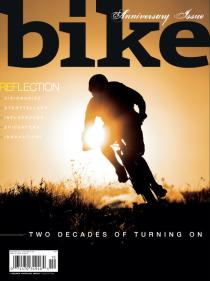
Such an opportunity came my way recently, or at least it appeared to.In early June, we had just posted the new Zephyr and I had been away from the canyon country for way too long. So I headed west to my hideaway in San Juan County. My plan was to avoid the computer altogether and get back into the red rocks. There were a few secret places I hoped to re-visit.But on June 3rd, I foolishly fired up my PC anyway. Waiting for me was an email from a man I had never heard of, Rob Story. He said he was a Zephyr “longtime listener/first-time caller” and his inquiry took me by surprise. He was contacting me on behalf of BIKE magazine, of all things, and was, in fact, its founding editor. Now he was putting together its 20th Anniversary Issue. Story made an offer that appealed to me on a couple levels. He wrote:“I assume you might have ambivalent feelings toward mountain bikers, but we’d really like you to contribute to BIKE Magazine’s 20th Anniversary Issue. We want to run a short feature on how Moab has changed/improved/Mormonized/
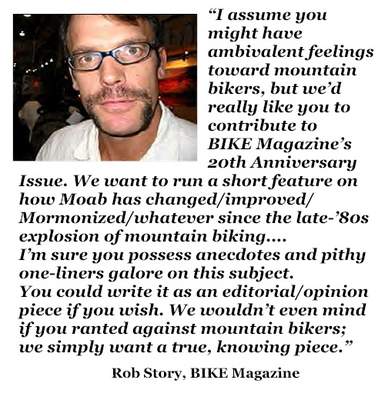 Second, the magazine would actually pay a fair fee for the work. Three months ago I was becoming increasingly concerned about declining Zephyr revenues. We were down to 13 advertisers and several dozen Backbone supporters. When I write for other magazines, I’m lucky to make a hundred bucks. Often I donate the essays. I kept telling our readers we were just trying to keep beans on the table. But now, even beans started to look like luxury food. So when Story offered a dollar a word for an essay that could run to 1600 words, it seemed like an opportunity to write something I could be proud of and be compensated for as well—a combination almost heretofore unknown in my writing experience.So I gave the idea serious consideration. The catch was, he needed the piece in eight days. And I had a catch as well. I wrote back:“You must be a very open minded person to ask me, of all people, to write about the influence of mountain biking in Moab. Right now, a 9 million dollar building project is underway, creating a concrete and steel “Elevated River Bikeway” that runs, not across, but parallel to, the Colorado River. It is an abomination; yet, few in ‘New Moab,’ a place I scarcely recognize anymore, expressed any objections.”“Moab is a zoo,” I said. I told Story I would take the assignment, but I warned him, “it would hardly be a piece that even remotely suggests that becoming the ‘Mountain Bike Capital of the World’ was a positive experience for most of us who lived there before 1987.”Story replied simply, “Awesome, Jim! Damn the torpedoes! Full speed ahead! Thanks again for writing this; can’t wait to read it.”
Second, the magazine would actually pay a fair fee for the work. Three months ago I was becoming increasingly concerned about declining Zephyr revenues. We were down to 13 advertisers and several dozen Backbone supporters. When I write for other magazines, I’m lucky to make a hundred bucks. Often I donate the essays. I kept telling our readers we were just trying to keep beans on the table. But now, even beans started to look like luxury food. So when Story offered a dollar a word for an essay that could run to 1600 words, it seemed like an opportunity to write something I could be proud of and be compensated for as well—a combination almost heretofore unknown in my writing experience.So I gave the idea serious consideration. The catch was, he needed the piece in eight days. And I had a catch as well. I wrote back:“You must be a very open minded person to ask me, of all people, to write about the influence of mountain biking in Moab. Right now, a 9 million dollar building project is underway, creating a concrete and steel “Elevated River Bikeway” that runs, not across, but parallel to, the Colorado River. It is an abomination; yet, few in ‘New Moab,’ a place I scarcely recognize anymore, expressed any objections.”“Moab is a zoo,” I said. I told Story I would take the assignment, but I warned him, “it would hardly be a piece that even remotely suggests that becoming the ‘Mountain Bike Capital of the World’ was a positive experience for most of us who lived there before 1987.”Story replied simply, “Awesome, Jim! Damn the torpedoes! Full speed ahead! Thanks again for writing this; can’t wait to read it.”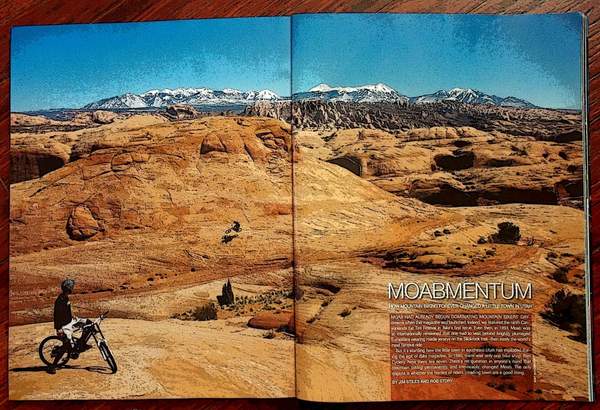 And so, for the next week or so, I hunkered down at my keyboard and hammered out a history of Moab’s last 20 years—a sad and sardonic tale of how my old home got from where it was to what it is, in1641 words. And yes, it was the “Stiles version.” After all, that’s what he wanted. On June 10, a day ahead of schedule, I emailed Story the completed work, along with a n assorted collection of relevant photos and cartoons I’d doodled over the years, just in case they needed images to accompany the story. Rob wrote back, “the piece looks damn good, thanks so much.” He advised that it would only need “light editing.” He was pleased. I was pleased. I’d finally been given a chance to write an unvarnished, bullshit-free account of Moab’s Transformation in a publication that rarely, if ever, agreed with anything The Zephyr had to say. The only periodical I can think of that will unhesitatingly publish ANY alternate point of view, no matter how abhorrent, is this one. To think that BIKE Mag might be of a similar ilk was a surprise to me. It seemed too good to be true. As it turns out, it was.
And so, for the next week or so, I hunkered down at my keyboard and hammered out a history of Moab’s last 20 years—a sad and sardonic tale of how my old home got from where it was to what it is, in1641 words. And yes, it was the “Stiles version.” After all, that’s what he wanted. On June 10, a day ahead of schedule, I emailed Story the completed work, along with a n assorted collection of relevant photos and cartoons I’d doodled over the years, just in case they needed images to accompany the story. Rob wrote back, “the piece looks damn good, thanks so much.” He advised that it would only need “light editing.” He was pleased. I was pleased. I’d finally been given a chance to write an unvarnished, bullshit-free account of Moab’s Transformation in a publication that rarely, if ever, agreed with anything The Zephyr had to say. The only periodical I can think of that will unhesitatingly publish ANY alternate point of view, no matter how abhorrent, is this one. To think that BIKE Mag might be of a similar ilk was a surprise to me. It seemed too good to be true. As it turns out, it was.
A few weeks passed and I’d heard nothing more so I sent Story an email on June 26. “Can I see a final edit before it goes to press?”No reply. Still, for reasons that now escape me, I trusted Story enough not to worry. Finally, more than a month after I sent the finished piece, an email showed up. He wrote, “There have been many changes with this Moab story.” Story explained that, “While I thought your first draft was solid, the other editors here at the magazine didn’t like it at all. They said, somewhat predictably, that it was way too anti-bike for an issue that’s dedicated to celebrating the past two decades of our sport. I eventually agreed.”Story apologized (I’ll give him that) but completely caved to his younger co-editors. “The other editors wanted to kill your piece altogether,” he wrote, “ and assign it to another writer, but I denied this request.” If he wasn’t in control to begin with, I wondered, how was he able to “deny” anything? For the first time he explained to me, “Not sure if I mentioned this before, but I’m only guest editing the 20th, not working here full time.” While Story didn’t seem to have much use for his younger peers (he called them “mawkish and gooey.”), they won him over to their point of view. Their perspective, he explained, “doesn’t jibe with the piece you submitted.” Instead, Story took a working vacation to Moab himself and in his words, “cobbled together a new piece that uses a few hundred words of your original copy.” My story was to be called “Oh for an Insuperable Moab,” a reference to a poignant passage by the 19th Century writer Henry James that describes the way America was destroying itself, even then.
 Instead, the “new story,” incredibly became, “Moab-mentum.” It contained BOTH of our bylines and by waiting until the very last moment to contact me, he advised, “ there isn’t much of a chance to make big changes.”My fee for writing the piece was slashed by 20% but Story told me I was lucky to get that (“…the other editors wanted to pay you only for the words we’re printing.”)With all that to mull over, I opened the attachment to read ‘our’ new story. It was strange.(NOTE) You can read the unedited version of this story, with all the deleted components of the story highlighted, by clicking here
Instead, the “new story,” incredibly became, “Moab-mentum.” It contained BOTH of our bylines and by waiting until the very last moment to contact me, he advised, “ there isn’t much of a chance to make big changes.”My fee for writing the piece was slashed by 20% but Story told me I was lucky to get that (“…the other editors wanted to pay you only for the words we’re printing.”)With all that to mull over, I opened the attachment to read ‘our’ new story. It was strange.(NOTE) You can read the unedited version of this story, with all the deleted components of the story highlighted, by clicking here Indeed a week’s worth of work had been hacked to pieces. Entire paragraphs vanished. In my version, I explained the transformation of Moab in the late 80s and the pork belly housing boom that followed, when mountain bikers came to Moab to ride and left town the next day, owning four homes for less than $100K. DELETED.
Indeed a week’s worth of work had been hacked to pieces. Entire paragraphs vanished. In my version, I explained the transformation of Moab in the late 80s and the pork belly housing boom that followed, when mountain bikers came to Moab to ride and left town the next day, owning four homes for less than $100K. DELETED.
My story began like this:
“Welcome to Moab, Utah, the “Mountain Bike Capital of the World. Adventure Vortex of the Universe! The Adrenalin Junkie’s Dream Destination! Wanna a take a ride? We’re spending millions to make your biking experience more pleasurable.”
When Story was done, this was the opener:
“Moab had already begun dominating mountain bikers’ daydreams when this magazine launched. Indeed, we featured the ninth Canyonlands Fat Tire Festival in Bike’s first issue. Even then, in 1993, Moab was so internationally renowned one had to wait behind brightly plumaged Germans wearing roadie jerseys on the Slickrock trail—easily the most famous path on the planet, then and now.”
I talked about the impacts of recreation and tourism on the land and included this quote from the Grand Canyon Trust’s Bill Hedden: “Industrial-strength recreation holds more potential to disrupt natural processes on a broad scale than just about anything else.” And how Greens had caved to the tourist dollars. DELETED.
Story came up with fluff like this:
“These days, you don’t even have to pedal to see that recreation has transformed Moab in ways uranium mining never could. You can tour the town with Moab Trolley Tours. You can sip Uintah Blanc at Castle Creek Winery. You can get a hot stone massage at Spa Moab. In addition to the expected bike rentals and tours, there’s also Moab Mountain Bike Instruction, which offers private lessons for just $100 per hour! We don’t know anybody who would ever pay for such a thing.”
He added little factoids like:
“According to a Colorado State University study, mountain bikers annually add $8.4 to $8.8 million to the small town’s economy. The study, released in 1997, showed that the average mountain biker stayed four days in Moab, along with 2.74 other friends. Whether hotel-dwelling gourmet or brown-bagging camper, each Moab rider spends about $200 there.”
Had I known BIKE wanted factoids, I could have provided a plethora. For example:
* An average home that sold for $30,000 in 1985 now fetches close to $300,000, making home ownership for people of modest incomes virtually impossible.
* In St. George, Utah, according to the Census Bureau, for every dollar generated in tax revenue per housing unit, each house consumed $2.70 in municipal services. Similar comparisons in the Yampa Valley, Colorado and the Madison Valley in Montana produced similar results.
* According to the American Farmland Trust, for every dollar paid in property taxes, the average U.S. urban resident uses $1.36 in public services, while the average farm uses only $.21 in similar services.
* A 2005 UN report reveals that “ tourism’s contribution to global warming was estimated to contribute between 5% and 14% to the overall warming caused by human emissions of greenhouse. By 2035, tourism’s contribution to climate change may have grown considerably.”
In the original essay, I explained the latest insult to the canyon backcountry, as a small core of Moab bike activists push to construct more single-track bike trails into wild country where no trails had existed. I described the new $10 million “Moab Hub” and the “Elevated River Bikeway.” The outrage turned to mush in the article:
“Still, mountain bikers can be fickle. Once incredible trails began popping up in other parts of the Four Corners (like Sedona, Cortez, and Fruita, to name three of the finest networks), riders started grumbling that Moab may enjoy the best sandstone riding anywhere, but it could use more singletrack.”
The backstory on the Elevated Bikeway disappeared altogether. Rob Story made one concession; perhaps the most obnoxious line in the ‘new’ piece was his absurd declaration:
“The next time someone tries to tell you mountain biking hasn’t helped Moab, laugh in his face.”
He removed the line, at my insistence and left a few of the more aggressive passages from the original. Specifically, he allowed a quote from the 19th Century novelist, Henry James, to remain. It was key to the essay and, in fact, summed up the story nicely. James wrote:
“You touch the great lonely land, only to plant upon it some ugliness (and), never dreaming of the grace of apology or contrition, you then proceed to brag with a cynicism of your own….I should owe you my grudge for every disfigurement and every violence, for every wound with which you have caused the face of the land to bleed…
“Oh for an unbridgeable abyss or an insuperable mountain.”
Now, the finished product was just plain weird. While the byline indicated the piece was co-written, it read like an essay at war with its own conscience, throwing out cheerful platitudes one moment, while grieving over the town’s loss of identity the next. As Story reminded me, it was “too late” to make changes, so all I could hope was that, at the very least, readers would come away bewildered and confused.
I thought the editing was over. I never again heard from Story or the other editors about the content of the essay. I assumed Story’s revision would at least make it to hard copy. But again, I was wrong. Without discussion, his younger, “mawkish and gooey” peers went to work with their own red pencils.
The Henry James quote, the key to the story, vanished. Other lines were deleted. Any references to Disneyland comparisons were chopped. Key words were altered. In the end, 90% of the ‘hard stuff’ in my version was deleted. A few lines slipped by their editing fingers. My guess is, either they didn’t understand the comment to begin with, or perhaps found no issue with an idea that would make some of us recoil in revulsion.
The concluding paragraph in the final cut was still a line I wrote:
“The Moab that preceded the mountain-bike phenomenon is gone. The old timers don’t really blame the bikes, or even the riders. They are merely conveyors of a consumer culture driven by an insatiable thirst for the next big thing—the next boom. It’s an American story, repeated again and again.”
Of the 1641 words I submitted to BIKE, I would hardly have expected them to find that sentiment any more palatable than the others they cut. And yet, maybe that’s the point of all this.
In their minds, is it possible that a “consumer culture, driven by an insatiable thirst for the next big thing,” is something to be desired and not loathed? Despite all that’s happened to Moab, you can still, it’s true, “sip Uintah Blanc at Castle Creek Winery”…and…”get a hot stone massage at Spa Moab.”
Is that what really makes a true community? Sad to say, in their minds, it is.
AUTHOR’S ADDENDUM:
A couple of postscripts—first you’ll be hard-pressed to find the final, sanitized version of my story. BIKE Magazine is available in print where you can find it (it’s the “20th Anniversary” issue), but is not accessible online except via a paid online subscription. Editor Rob Story said it was unlikely BIKE would be interested in promoting the piece on the internet. And in the print edition, it’s buried in the back, on page 128.
(Copyright laws prohibit me from posting the version that appears in their magazine. However I retain the copyright on the original story and it is posted elsewhere in this issue.)
Despite the fact that my original version was gutted and turned mostly to mush, apparently Moab’s mountain biking elite are not pleased with the final edit. Some of the more outspoken members of “Trail Mix” have expressed displeasure with the piece, suggesting that since I don’t live in Moab anymore, I have relinquished the right to offer an opinion. Of course, they promote an industry that is 95% fueled by people who don’t live in Moab either. At least I put in my 30 years.
Finally, a couple of readers have already grumbled that since I was paid for the story, I have no right to complain about the changes.Obviously, I disagree. I took the assignment with the assurance it would be allowed to stand as I wrote it. If a painter submits a work for publication, gets paid, but then finds that the editors have graffitied his artwork with obscenities, does the artist have the right to object? Of course he does. I have already been contacted by the editor of a regional newspaper who asked why, in effect, I had sold out. She was relieved to learn I hadn’t. That’s why I felt compelled to tell the story you’ve just read and to offer the unedited, unsanitized original version–“Oh for an Insuperable Moab.”
To read the PDF version of this article, click here.
Don’t forget the Zephyr ads! All links are hot!

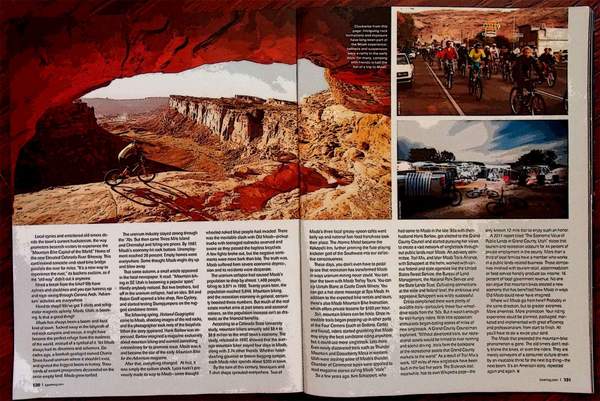

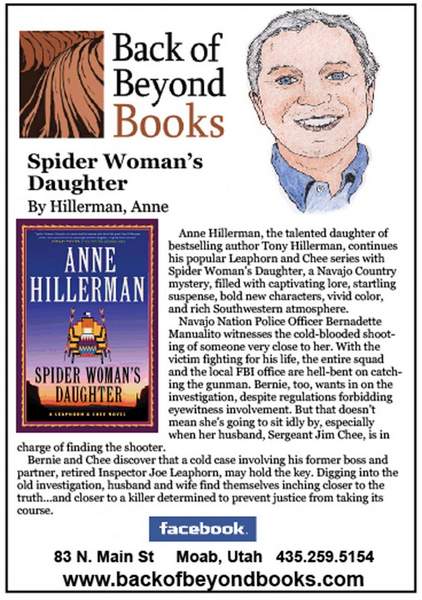
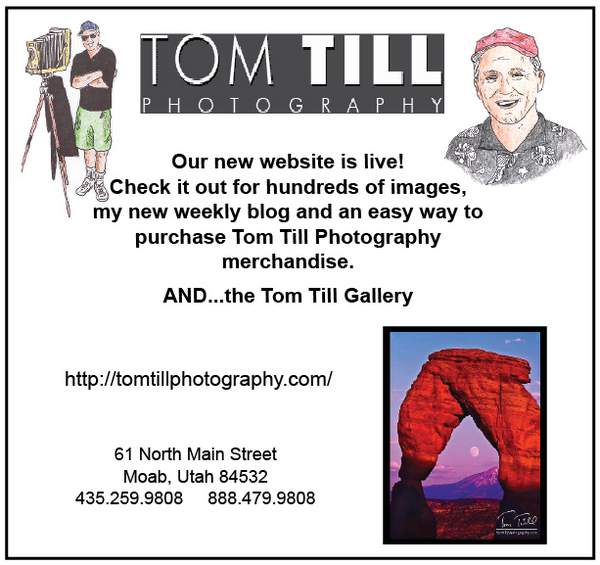
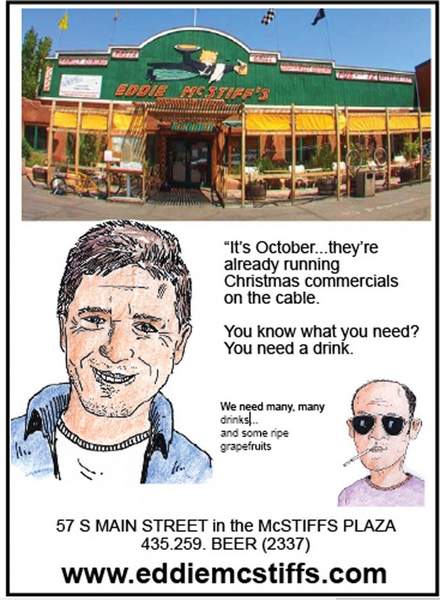
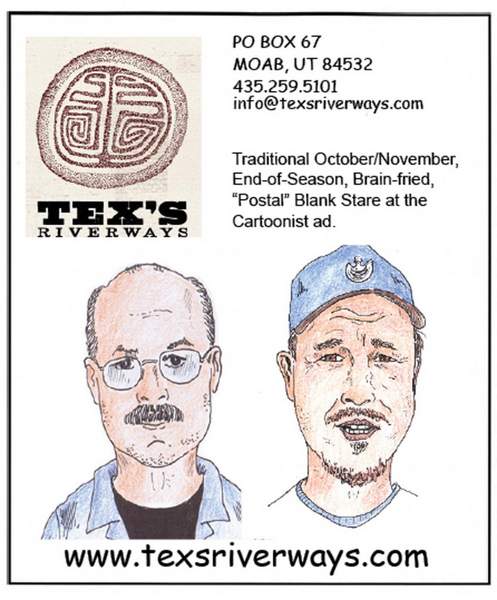

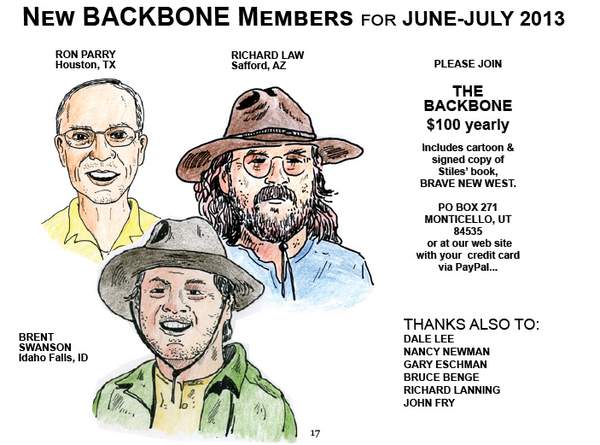
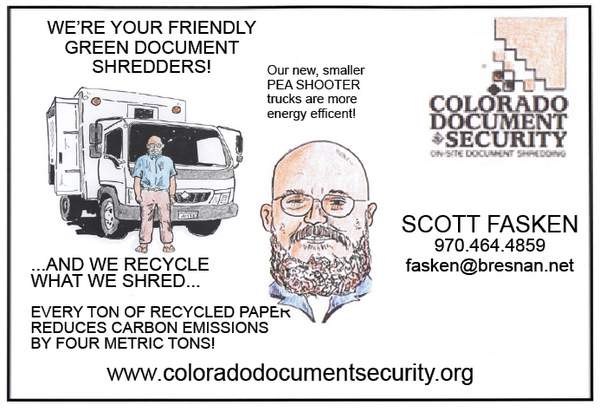
Magazine publishing has always been like that, still is, and I think it’s safe to bet it always will be – that’s why I don’t submit to magazines anymore. This was an especially horrific instance of the abuse writers routinely suffer and have always suffered. What’s different today is that the society as a whole is evolving into a system where material success trumps ethical values, i.e., stealing is now OK, if you can get away with it – the Internet is rife with copyright violations. But back to your personal experience, for me one of the most disturbing things in your account is that some of your own readers think you have no right to complain. Hellooooo?
It appears to me that Jim S. handled a bizarre situation as well as he could. Obviously, Biker magazine would be pro biker. They had to know what they were asking for and what they would get. The sad part of this is that the truth (as some of us see it) couldn’t be faced or presented. Moab is a sad tale of what happened to a special place. It was simply radically changed in a short period of time. A place that some of us only dream about into something we see everyday.
Jim, thank you for sharing the tale of how of your story was massacred by BIKE magazine. I think this shows that your gift for delineating that which is absurd makes those who can’t do it, much less understand it, VERY uncomfortable.
Thus they react without grace or understanding.
We have seen the future and, sad to say, it is Moab.
Hi Jim:
Thanks for this–the Internet is an awesomely linkable place (kinda the point). You never know how valuable this contribution (and all the others) are and can be in a rather fast fashion. Trends shift quickly as fast one way as they do the others these days. One man is a madman, two is a conspiracy, three is a revolution. Let’s keep pushing to retain the glorious beauty of our Southwest.
Matt (Backbone Member)
Yes, I agree that this whole Bike magazine fiasco you experienced was very unprofessional of them. In fact, in the ‘Letters to the Editor’ section of their December 2013 issue, they acknowledge and apologize to the readers for this article. And, in a way, to you, by stating they should’ve just paid you and not printed the article, and also acknowledging that Rob Story is a bit of a tool.
Jim, I’ve been a long time reader and lover of the Canyon Country Zephyr for a couple decades. As a lover of southeastern Utah, as a longtime resident, and as an environmental professional and advocate, I really enjoy your writing and articles. However, as a long time mountain biker, I wince at many of your comments. I find them so discriminatory how you categorize a group of people, mountain bikers, as all one type of person with similar actions and visions. I enjoy and protect the red rock deserts and mountain ranges, and enjoy them by hiking and biking. I am usually by myself, enjoying nature on a solo basis. (Yes, if you are a knowledgeable local mountain biker, it is actually easy to escape the hordes of tourists). I stay on designated trails, singletracks or roads, and pedal for miles, enjoying the serenity and beauty around me. My bike is a form of transportation to explore southeastern Utah. A bike is much quieter than a car to reach remote areas, much more environmentally friendly, and I get fit in the process.
I know you and other ‘old-timers’ of ‘former Moab’ tend to focus on mountain bikers being the evil that changed your worlds. I still hear it around town, but only in the 55+ age group. Yes, I’m sure that was the case in the late 1980s/ early 1990s. But guess what? Moab has changed again. Mountain bikers are actually a minority to the current most popular group of visitors: motorized users. Yep, Jeeps, ATVs, motorbikes, and especially UTVs (side by side ATVs) are BY FAR the dominant user in southeastern Utah now, and it’s been this way for several years. Whether it’s Billy Joe Jimbob with his trailer of motorized toys, or the folks hauling UTVs behind their $300,000 RV, every year the number of these motorized users increase. In fact, writing to you this Thanksgiving weekend, the number of UTVs and Jeeps up at Sand Flats and the Gemini Bridges area is unprecedented. We just had a record 8” snow fall in the area, so the muddy desert is being trashed by motorized users. (Yes, there are some idiot tourist mountain bikers on the muddy singletrack trails, but most mountain bikers are smart enough to stay on the Slickrock trail when it’s muddy). There are multiple under-the-radar UTV rallies each year in Moab alone. Again, I’m sure there are eco-conscious motorized users, but the number of tire tracks from motorized vehicles going across the virgin crypotbiotic crust almost makes me cry. They go around gates that read “road closed” and “rehabilitation area” and crush the desert. They are rarely mountain bike tracks doing this- we have close to a hundred miles of new, non- motorized singletrack that keeps us all happy and separated from motoheads.
Anyways, please read Sharon Hogan’s letter to the editor in the December 2013 issue of Bike magazine. Again, I appreciate the Canyon Country Zephyr’s historical view of this area, but it’s becoming a little dated. I think you’ve moved out of state, so are probably missing the day-to-day life scene in Grand and San Juan Counties, but issues are changing. Moab is Moab, and frankly, the town doesn’t seem much different to me from 20 years ago. Just more second homes being built like crazy, and the non-Jeep motorized users have increased dramatically. Thanks.
Jean…I appreciate your comments but you still somehow miss the point. The issue here has never been solely about the sport of mountain biking. I even wrote in the BIKE story:
“We don’t really blame the bikes, or even the riders. They are merely conveyors of a consumer culture, driven by an insatiable thirst for the next Big Thing–the next Boom. It’s an American story, repeated again and again.”
It’s about Greed, it’s about obscene excess, it’s about taking the last unspoiled idea—the natural beauty of the land—and finding a way to squeeze every ounce of profit imaginable out of it. It’s about the “entrepreneurial spirit” even infecting the grassroots environmental movement with it. It’s the utter contempt of New Moabites for everything and everyone that came before. Most New Moabites’ knowledge of the area goes back to the day they arrived. Their lack of knowledge is shameful. Their lack of sensitivity is unforgivable. You say my “historical view is dated.” History IS dated, because it’s history. And I find few New Moabites who give a damn about any of it.
In any case, currently the very same people who have led the effort to transform Moab are taking aim at Monticello and San Juan County. If the information I provide them can help deter the kind of ruthless onslaught of money and power that you seem so admiring of, then I feel I am providing a service.
And finally, if you really can’t tell a difference in Moab between 1993 and 2013, then you and I are just wired differently. And I think that’s exactly the point.
The day I was having a serene hike with my dogs and two mountain bikes came seemingly from nowhere nearly wiping out one pup while I dove to shove them out of the way was the day I knew my time in Moab was limited. After nearly two decades it was the constant noise that put me over the edge. Bitter doesn’t begin to capture my feelings.